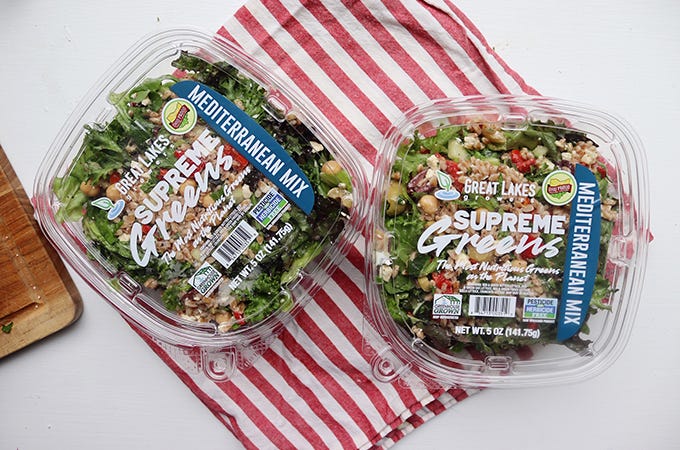Think You’re Eating Mediterranean? Think again.
Recipe: Coconut Almond Cake with Cherries & Red Walnuts & Coconut Glaze
*This newsletter is not intended to be medical advice. Supported by Mandy Murphy Carroll, RD MPH, Dr. Rosa Keller, PHD RD, Dr. Ricki Pollycove OBGYN, & Dr. Claire Packer OBGYN
Welcome to Modern Women’s Nutrition!
Empowering the busy modern woman to understand her hormone & metabolic health, and how to eat to thrive at every step of her journey—from fertility to menopause and beyond.
→ Jump to Recipe: Almond Cake with Cherries & Red Walnuts & Coconut Glaze
Hi gals,
I was in the states for a few meetings last week and found myself standing in the deli section of a fancy Bay Area grocery store. I was hungry, short on time, and looking to grab something healthy. I spotted a little plastic bowl labeled Mediterranean Power Bowl and thought, Boom. Lunch.
Here’s what was inside: a scoop of hummus (made with canola oil—yuck), grilled chicken (overcooked, coated in a sugary sauce that has ingredients I didn’t recognize), white rice, a tired cucumber wedge, a few triangles of stale pita, and an aggressively orange dressing. And…a bit of arugula.
In a hurry, I ate it, while picking around the pieces that looked extra questionable. Thirty minutes later, I had a headache and, while feeling bloated, was also still kind of hungry and unsatisfied.
I started thinking about an ongoing theme I am noticing: the popularity of “a Mediterranean diet”, and yet what it means to label something “Mediterranean”.
What is the current state of the once touted Mediterranean Diet, anyway?
For starters, it seems that The Mediterranean Diet has become a catch-all category for any food or foods remotely connected to countries set against the Mediterranean Sea, including Southern Europe, North Africa, and parts of the Middle East. These days the moniker is tossed around casually, completely detached from its founding principles, encompassing everything from pizza and pasta to mayo-based dips, white flour breads and pita, white rice, and greasy fries.
Somewhere between the Instagram bowls and bottled dressings, the Med Diet has lost the plot.
But when you look back at what the diet actually was—what people in post-war Crete, Calabria, and Ikaria were eating—you find something else entirely: meals built from plants, legumes, broth, garlic, and herbs. Cold-pressed olive oil poured generously over everything, with a sprinkle of thick flaky sea salt. Food grown in gardens, cooked slowly, and consumed in good company. Not gourmet, not “clean,” not packed in a plastic to-go container X days beforehand. Just real.
So, let’s dig into what the Mediterranean diet really is, what it was never meant to be, and how we can bring the OG version—deeply healing, hormone-supportive, and blood-sugar-steadying foods—back to our modern kitchens.
The Mediterranean Diet originally followed these eating guidelines with plates that included:
Bitter greens, legumes, alliums (garlic & onion), herbs
Fermented sourdough made with the whole what grain (including the fiberous husk) or whole barley bread
Freshly caught fish or creamy tangy sheep’s milk cheese
Generous use of extra virgin olive oil
Zero ultra-processed foods
What it wasn’t:
White flour-laden pizzas and pastas, stripped of all fiber in the flour
Store-bought hummus with preservatives
Seed oils from who-knows-where
Greasy fried foods
“Power bowls” built on white rice and heavy sauces
Packaged snacks labeled “Mediterranean” to catch your eye
And the original Mediterranean diet wasn’t just about what you ate, it was about how you ate. Slowness, seasonality, home cooking, and connection were built into the rhythm. That’s what made it effective, and joyful!
Several large-scale studies now show that even in Mediterranean countries, the classic, enriching diet is slipping away, and chronic illness is rising in response.
A 2022 systematic review found that adherence to the Mediterranean diet is declining across Europe, including in Italy, Spain, and Greece—especially among younger generations (Martínez-González et al., Nutrients, 2022).
The ZOOM8 study of 40,000+ Italian schoolchildren found that only 5% had high adherence to the diet, while nearly 33% had poor adherence (Bianchi et al., Public Health Nutrition, 2014).
Childhood obesity in southern Italy now exceeds 43% in children ages 8–9, with nearly 19% classified as obese—driven by increased consumption of processed snacks and sugary drinks (WHO Europe, 2022).
And according to a 2024 study published in American Journal of Preventive Medicine, for every 10% increase in ultra-processed food intake, there’s a 2.7% increase in all-cause mortality. The same study linked these foods to 124,000 premature deaths annually in the U.S. (Wang et al., 2024)
In short: the further we drift from simple, real food, the more disease we see.
The original Mediterranean diet is one of the most studied dietary patterns for longevity, hormone regulation, fertility, mental clarity, and metabolic health.
It’s rich in:
Anti-inflammatory fats (especially omega-3s)
Fiber to support blood sugar and estrogen metabolism
B vitamins and minerals that regulate cortisol
Gut-friendly, brain-supportive polyphenols
For women navigating perimenopause, postpartum depletion, blood sugar instability, or just the relentless stress of our overflowing lives, it’s not just “a healthy diet.” It’s a therapeutic one.
The good news? You can bring it back without relocating to a Greek island (though that sounds amazing) or giving up pleasurable eating.
So how do you reclaim the real Mediterranean magic in a real-life kitchen?
You start here.
Paid subscribers: Get my 5 top tips for real Mediterranean eating + the delicious recipe of the week: Coconut Almond Cake with Cherries & Red Walnuts & Coconut Glaze.
Keep reading with a 7-day free trial
Subscribe to Modern Women's Nutrition to keep reading this post and get 7 days of free access to the full post archives.









